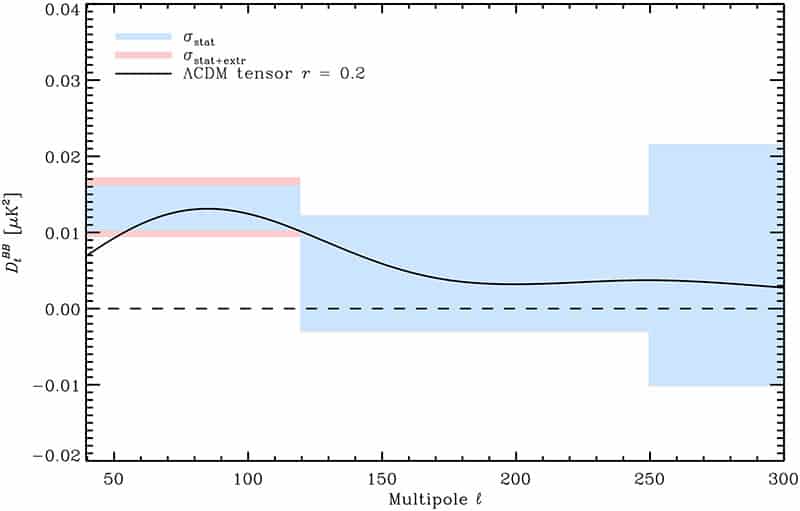BICEP2 was a small-aperture, ground-based telescope built to measure polarization in the Cosmic microwave background and search for degree-scale B-mode patterns as a signature of inflationary Gravitational waves, operating at the Amundsen–Scott South Pole Station to exploit its dry, stable atmosphere and long polar night observing conditions. Center for Astrophysics | Harvard & Smithsonian describes BICEP as originally standing for “Background Imaging of Cosmic Extragalactic Polarization,” with BICEP2 replacing BICEP1 in 2010 as the second-generation instrument of the program.
Center for Astrophysics | Harvard & Smithsonian;
NIST.
Instrument and site
BICEP2 employed a 26 cm, cold, on-axis refracting optical system with a single 150 GHz band and a focal plane of antenna-coupled transition-edge sensor (TES) bolometers optimized for degree-scale polarization sensitivity. Astrophysical Journal reports the instrument’s on-axis refractive optics and TES design, while the detection paper details a 26 cm aperture and a focal plane of 512 150 GHz TES bolometers (256 polarization-sensitive pairs).
Astrophysical Journal;
Physical Review Letters.
Operating from the South Pole provided year-long stability, very low atmospheric water vapor, and an altitude exceeding 2,700 m (roughly 9,000 ft), conditions advantageous for microwave polarization measurements. NIST. The collaboration observed a low-foreground patch of sky of roughly 380–400 square degrees, targeting multipoles ℓ ≈ 30–150 near the expected B-mode peak at degree scales.
Physical Review Letters. BICEP2 achieved deep Q/U maps with per-pixel depths of about 5.2 μK·arcmin over an effective area of ~384 deg² within a wider ~1000 deg² field, representing the deepest degree-scale CMB polarization maps of its time.
Astrophysical Journal.
Observations (2010–2012)
BICEP2 observed during three austral winters from 2010 through 2012, using a single 150 GHz frequency to maximize raw sensitivity to the CMB B-mode signal at degree angular scales. Physical Review Letters. The instrument’s antenna-coupled TES arrays and multiplexed readout enabled a high detector count and background-limited performance at South Pole conditions.
Astrophysical Journal. The program built on BICEP1 and was complemented by the Keck Array, essentially five BICEP2-class receivers observing the same field, and later by BICEP3 and the BICEP Array.
Center for Astrophysics | Harvard & Smithsonian;
Stanford CMB.
2014 B-mode announcement
On March 17, 2014, the collaboration announced a high-significance excess of degree-scale B-mode power over the lensed-ΛCDM expectation, initially interpreted as evidence for primordial tensor modes with a tensor-to-scalar ratio r ≈ 0.20 (+0.07/−0.05), and presented at a press conference at Harvard–Smithsonian. Physical Review Letters;
Center for Astrophysics | Harvard & Smithsonian (news release with later correction). The collaboration’s PRL article reported a >5σ excess in 30 < ℓ < 150 and extensive null tests against instrumental systematics and synchrotron contamination, with the caveat that the interpretation depended on then-uncertain dust polarization models.
Physical Review Letters.
Foreground dust and re-evaluation with Planck
Subsequent analyses and new data on polarized Galactic dust from [Planck (spacecraft)] indicated that polarized thermal dust emission at high Galactic latitude could account for a large fraction, and potentially all, of the observed BICEP2 B-mode signal at 150 GHz. Astronomy & Astrophysics;
Astronomy & Astrophysics. Independent re-analyses highlighted the range of plausible dust amplitudes and emphasized the need for multi-frequency data to separate CMB from foregrounds.
arXiv:1405.7351. A formal joint analysis by the BICEP2/Keck Array and Planck collaborations modeled lensed ΛCDM + dust + possible tensors, finding strong evidence for dust and no statistically significant tensor signal, yielding r0.05 < 0.12 (95% C.L.).
Physical Review Letters. The CfA subsequently amended its March 17, 2014 news release to reflect that interpretation.
Center for Astrophysics | Harvard & Smithsonian (news release with later correction).
Later constraints from BICEP/Keck and Planck
With additional receivers, expanded frequency coverage (including 95 and 220 GHz), and deeper maps, the BICEP/Keck program progressively tightened limits on tensors when analyzed jointly with Planck and WMAP data. Stanford CMB. The 2021 BICEP/Keck analysis using data through the 2018 season reported r0.05 < 0.036 (95% C.L.), the strongest then-current bound, obtained from multi-frequency spectra and a foreground model without external priors on dust spectral index.
Physical Review Letters;
OSTI. Planck’s cosmological parameter analyses likewise report tight combined limits on r when including BICEP/Keck constraints.
Astronomy & Astrophysics.
Technical performance and data products
Instrument characterization indicates an instrument noise-equivalent temperature of ~15.8 μK√s and Stokes Q/U map depths of ~87 nK·deg for the three-year data set, with angular scales ℓ ≈ 40–200 and a principal science band at 150 GHz. Astrophysical Journal. The 2014 detection paper details the optical design, detector layout, calibration, null tests, and cross-checks with BICEP1 100 GHz maps, in addition to presenting the B-mode power spectrum measurement in the target multipole range.
Physical Review Letters. The joint 2015 BICEP2/Keck and Planck analysis detects lensing B-modes at 7σ while placing the aforementioned upper limit on r, providing a template for multi-experiment foreground separation at degree scales.
Physical Review Letters.
Program context and successors
BICEP2 succeeded BICEP1 and preceded the Keck Array, BICEP3, and the multi-receiver BICEP Array, which extend frequency coverage and detector count to improve foreground separation and sensitivity to inflationary B-modes. Center for Astrophysics | Harvard & Smithsonian;
Stanford CMB. The South Pole site remains central to these efforts, offering minimal precipitable water vapor and continuous observing during the austral winter.
NIST.
